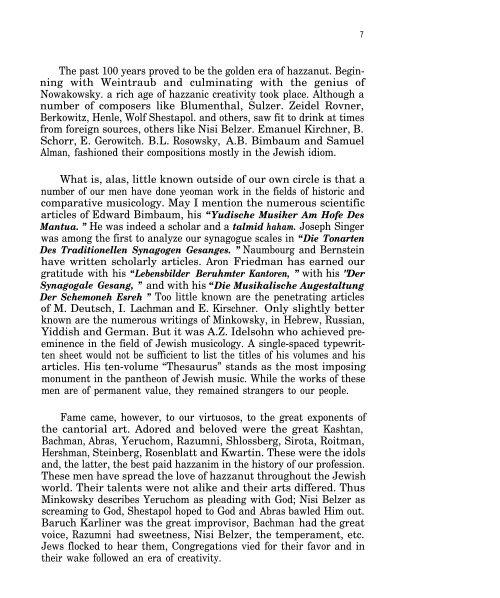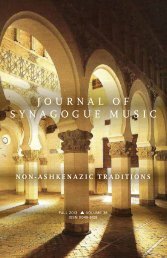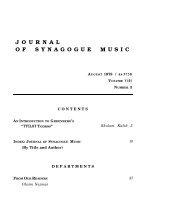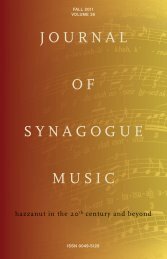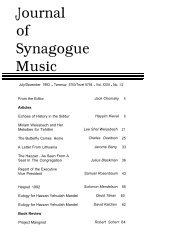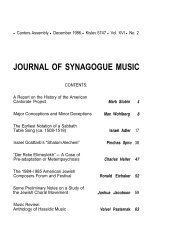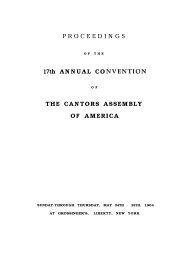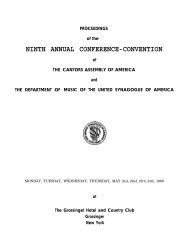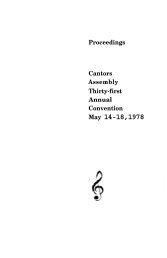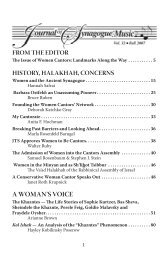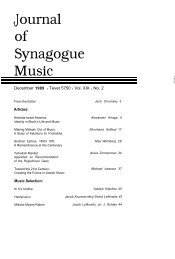Volume 7, Number 3 - Cantors Assembly
Volume 7, Number 3 - Cantors Assembly
Volume 7, Number 3 - Cantors Assembly
Create successful ePaper yourself
Turn your PDF publications into a flip-book with our unique Google optimized e-Paper software.
The past 100 years proved to be the golden era of hazzanut. Beginning<br />
with Weintraub and culminating with the genius of<br />
Nowakowsky. a rich age of hazzanic creativity took place. Although a<br />
number of composers like Blumenthal, Sulzer. Zeidel Rovner,<br />
Berkowitz, Henle, Wolf Shestapol. and others, saw fit to drink at times<br />
from foreign sources, others like Nisi Belzer. Emanuel Kirchner, B.<br />
Schorr, E. Gerowitch. B.L. Rosowsky, A.B. Bimbaum and Samuel<br />
Alman, fashioned their compositions mostly in the Jewish idiom.<br />
What is, alas, little known outside of our own circle is that a<br />
number of our men have done yeoman work in the fields of historic and<br />
comparative musicology. May I mention the numerous scientific<br />
articles of Edward Bimbaum, his “Yudische Musiker Am Hofe Des<br />
Mantua. ” He was indeed a scholar and a talmid haham. Joseph Singer<br />
was among the first to analyze our synagogue scales in “Die Tonarten<br />
Des Traditionellen Synagogen Gesanges. ” Naumbourg and Bernstein<br />
have written scholarly articles. Aron Friedman has earned our<br />
gratitude with his “Lebensbilder Beruhmter Kantoren, ” with his "Der<br />
Synagogale Gesang, ” and with his “Die Musikalische Augestaltung<br />
Der Schemoneh Esreh ” Too little known are the penetrating articles<br />
of M. Deutsch, I. Lachman and E. Kirschner. Only slightly better<br />
known are the numerous writings of Minkowsky, in Hebrew, Russian,<br />
Yiddish and German. But it was A.Z. Idelsohn who achieved preeminence<br />
in the field of Jewish musicology. A single-spaced typewritten<br />
sheet would not be sufficient to list the titles of his volumes and his<br />
articles. His ten-volume “Thesaurus” stands as the most imposing<br />
monument in the pantheon of Jewish music. While the works of these<br />
men are of permanent value, they remained strangers to our people.<br />
Fame came, however, to our virtuosos, to the great exponents of<br />
the cantorial art. Adored and beloved were the great Kashtan,<br />
Bachman, Abras, Yeruchom, Razumni, Shlossberg, Sirota, Roitman,<br />
Hershman, Steinberg, Rosenblatt and Kwartin. These were the idols<br />
and, the latter, the best paid hazzanim in the history of our profession.<br />
These men have spread the love of hazzanut throughout the Jewish<br />
world. Their talents were not alike and their arts differed. Thus<br />
Minkowsky describes Yeruchom as pleading with God; Nisi Belzer as<br />
screaming to God, Shestapol hoped to God and Abras bawled Him out.<br />
Baruch Karliner was the great improvisor, Bachman had the great<br />
voice, Razumni had sweetness, Nisi Belzer, the temperament, etc.<br />
Jews flocked to hear them, Congregations vied for their favor and in<br />
their wake followed an era of creativity.<br />
7


